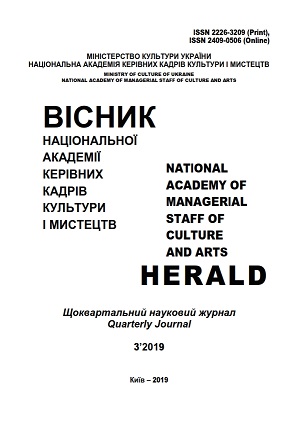Innovations in Arts and Cultural Education: Experience of the Kyiv National University of Culture and Arts
Innovations in Arts and Cultural Education: Experience of the Kyiv National University of Culture and Arts
Author(s): Mykhailo Mykhaylovych PoplavskyiSubject(s): Fine Arts / Performing Arts, Culture and social structure , Higher Education , Sociology of Education
Published by: Національна академія керівних кадрів культури і мистецтв
Keywords: higher arts and cultural education; MA`s creative project; educational model;
Summary/Abstract: The features of arts and cultural education in the context of general trends in social development are studied. The issues of professional training of arts and culture-related experts are relevant not only for Ukraine but also for other European countries, which experience attracts the attention of researchers and experts who are trying to apply it in higher school. The purpose of the article is to reveal the experience of MA in education in arts and culture setting, combining traditional and up-to-date programs of study. There is research in the methodology of historical and theoretical analysis and modeling approaches. With all the progressiveness of educational technologies offered by modern pedagogical science, one should not abandon the historical experience in this field. With all the progressiveness and relevance of training technologies offered by modern educational science, one should not refuse from historical experience in this area. The Kyiv National University of Culture and Arts successfully test various educational models, in particular, retro- archaic and creative. The retro-archaic model combines the fringe locality of teaching (teacher) and modern information technologies, thanks to which the recipient does not just receive information, but also ―school‖ oneself. This model is elite, exclusive and exotic, despite its retro-archaic backgrounds. The creative model prevents from providing knowledge as impersonal information. It is especially relevant in the arts and cultural teaching of students that based on the direct share of experience (skill) and the value of interpersonal communication. The university uses both models in the preparation of creative projects by students as one of the forms of graduate qualification work for the degree of master. The scientific novelty of the article consists in revealing the experience of master's art design that meets the key features of modern cultural and creative activity - cultural potential, social-cultural demand, theoretical and framework rationale, aesthetic-art and ethical-educational focus, commercial and recreational-entertaining ―performance‖. Conclusions. We call such a setting for the formation of project competencies a ―crossover point‖ (in English - ―intersection point‖, ―intersection‖) as the principle of preparation and presentation of a creative project. There are test laboratories that work as workshops for teaching arts and culture-related students (audio-visual arts and production, design, choreography, musical art, and stage art). It is developed and tested an ―ideal‖ model for the training of masters in the process of creative and design activity. MA`s creative project contains both research and experimental backgrounds combining design modeling and scientific activity. Conclusions. We believe that it is necessary to develop a creative education research program, a non-aggressive and non-constructive approach based on cultural and historical reenactment, design-model analysis and creative thinking. It will allow us to form not only a creative personality, but also a creative community, and creative society.
Journal: Вісник Національної академії керівних кадрів культури і мистецтв
- Issue Year: 2019
- Issue No: 3
- Page Range: 3-8
- Page Count: 6
- Language: English

